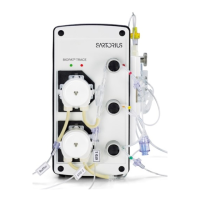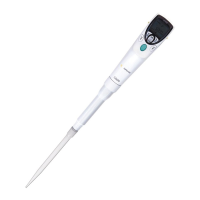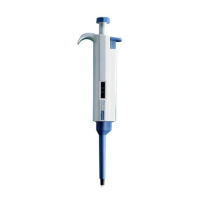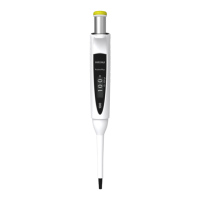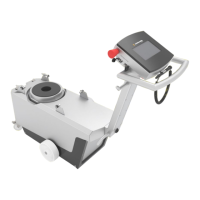12
0
1
2
6.3 Reverse Pipetting
Reverse pipetting is recommended for highly viscous, biological, or foaming liquids, or very small volumes. The selected volume is
aspirated into the tip along with an excess volume. Delivery is done without blow-out ensuring the excess volume remains in the tip.
This excess is then discarded after the selected volume is aspirated. You may need to adjust the pipette in order to use the reverse
pipetting technique.
1. Fit the tip onto the pipette tip cone.
2. Press the operating button all the way to the second stop.
3. Place the tip just under the surface of the liquid and smoothly release the operating button, allowing it to return to the starting
position.
4. Carefully withdraw the tip from the liquid, touching it against the edge of the container to remove any excess from the tip.
5. Press the operating button smoothly to the first stop to deliver the desired volume. The liquid that remains in the tip should not
be included in the delivery.
6. Discard the remaining liquid by pressing the operating button to the second stop.
6.4 Repetitive Reverse Pipetting
The reverse technique allows you to repeatedly deliver the same volume.
1. Follow steps 1 to 5 of the reverse-pipetting technique above (see 6.3, Reverse pipetting).
2. Repeat steps 3 to 5 as many times as necessary.
3. Discard the remaining liquid by pressing the operating button to the second stop.
7. Maintaining the Pipette
The Tacta® pipette range has been designed for easy in-house service. If the pipette is in daily use, we recommend you clean and
decontaminate it and check its performance every three months. Sartorius also provides a complete repair and calibration service,
including a service report and performance certificate.
Disinfecting the Pipette
Disinfectant liquid
Always ensure the pipette materials are chemically compatible with the detergent, disinfectant, or decontaminant liquids you plan to
use. See 1.1, Pipette parts and materials for information on pipette materials. For information on chemical compatibility, please send a
request by email to lhinfo.finland@sartorius.com.
NOTE: Make sure the pipette has been decontaminated before you send it for repair or calibration. Be sure to note any hazardous
material that the pipette has been exposed to. For more information see 7.3, Sterilizing the pipette.
NOTE: Using tip cone filters may lengthen the service interval. Change filters regularly.
NOTE: We recommend always using gloves when cleaning the pipette.

